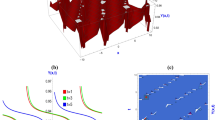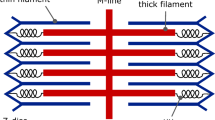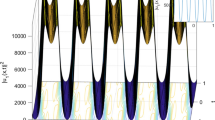Abstract
This work proposes an optimal control approach for the termination of re-entry waves in cardiac electrophysiology. The control enters as an extracellular current density into the bidomain equations which are well established model equations in the literature to describe the electrical behavior of the cardiac tissue. The optimal control formulation is inspired, in part, by the dynamical systems behavior of the underlying system of differential equations. Existence of optimal controls is established and the optimality system is derived formally. The numerical realization is described in detail and numerical experiments, which demonstrate the capability of influencing and terminating reentry phenomena, are presented.
Similar content being viewed by others
References
Ashihara T, Namba T, Ito M, Ikeda T, Nakazava K, Trayanova N (2004) Spiral wave control by a localized stimulus:. J Cardiovasc Electrophysiol 15(2): 226–233
Aubin JP (1963) Un thěorème de compacitě. C R Acad Sci 256: 5042–5044
Bardy GH, Hofer B, Johnson G, Kudenchuk PJ, Poole JE, Dolack GL, Gleva M, Mitchell R, Kelso D (1993) Implantable transvenous cardioverter-defibrillators. Circulation 87(4): 1152–1168
Bastian P, Blatt M, Dedner A, Engwer C, Klöfkorn R, Kornhuber R, Ohlberger M, Sander O (2008) A generic grid interface for parallel and adaptive scientific computing. Part II: implementation and tests in DUNE. Computing 82(2): 121–138
Bishop MJ, Rowley A, Rodriguez B, Plank G, Gavaghan DJ, Bub G (2011) The role of photon scattering in voltage-calcium fluorescent recordings of ventricular fibrillation. Biophys J 101(2): 307–318
Bochev P, Lehoucq RB (2005) On the finite element solution of the pure Neumann problem. SIAM Rev 47: 50–66
Bourgault Y, Coudiére Y, Pierre C (2009) Existence and uniqueness of the solution for the bidomain model used in cardiac electrophysiology. Nonlinear Anal: Real World Appl 10(1): 458–482
Chen PS, Shibata N, Dixon EG, Martin RO, Ideker RE (1986) Comparison of the defibrillation threshold and the upper limit of ventricular vulnerability. Circulation 73(5): 1022–1028
Cheng DK, Tung L, Sobie EA (1999) Nonuniform responses of transmembrane potential during electric field stimulation of single cardiac cells. Am J Physiol 277(1 Pt 2): H351–H362
de Bakker JMT, van Rijen HMV (2006) Continuous and discontinuous propagation in heart muscle. J Cardiovasc Electrophysiol 17(5): 567–573
De Bruin K, Krassowska W (1998) Electroporation and shock-induced transmembrane potential in a cardiac fiber during defibrillation strength shocks. Ann Biomed Eng 26: 584–596
Gustafsson K, Lundh M, Söderlind G (1988) A PI stepsize control for the numerical solution of ordinary differential equations. BIT 28(2): 270–287
Henriquez CS (1993) Simulating the electrical behavior of cardiac tissue using the bidomain model. Crit Rev Biomed Eng 21: 1–77
Hillman EMC, Bernus O, Pease E, Bouchard MB, Pertsov A (2007) Depth-resolved optical imaging of transmural electrical propagation in perfused heart. Opt Express 15(26): 17827–17841
Hooks DA, Trew ML (2008) Construction and validation of a plunge electrode array for three-dimensional determination of conductivity in the heart. IEEE Trans Biomed Eng 55(2 Pt 1): 626–635
Kuijpers NHL, Keldermann RH, Arts T., Hilbers PAJ (2005) Computer simulations of successful defibrillation in decoupled and non-uniform cardiac tissue. Europace 7(s2): S166–S177
Kunisch K, Wagner M (2011) Optimal control of the bidomain system (ii): uniqueness and regularity theorems for weak solutions. University of Graz
Kuppahally SS, Akoum N, Burgon NS, Badger TJ, Kholmovski EG, Vijayakumar S, Rao SN, Blauer J, Fish EN, Dibella EVR, Macleod RS, McGann C, Litwin SE, Marrouche NF (2010) Left atrial strain and strain rate in patients with paroxysmal and persistent atrial fibrillation: relationship to left atrial structural remodeling detected by delayed-enhancement MRI. Circ Cardiovasc Imaging 3(3): 231–239
Lang J, Teleaga D (2008) Towards a fully space-time adaptive FEM for magnetoquasistatics. IEEE Trans Magnet 44(6): 1238–1241
Murray JD (2001) Mathematical biology: I. An introduction. Springer, Heidelberg
Nagaiah C, Kunisch K (2011) Higher order optimization and adaptive numerical solution for optimal control of monodomain equations in cardiac electrophysiology. Appl Numer Math 61: 53–65
Nagaiah C, Kunisch K, Plank G (2011) Numerical solution for optimal control of the reaction-diffusion equations in cardiac electrophysiology. Comput Optim Appl 49: 149–178. doi:10.1007/s10589-009-9280-3
Niederer S, Mitchell L, Smith N, Plank G (2011) Simulating human cardiac electrophysiology on clinical time-scales. Front Physiol 2: 14
Nocedal J, Wright SJ (2006) Numerical optimization, 2nd edn. Springer, New York
Pavarino LF, Scacchi S (2008) Multilevel additive Schwarz preconditioners for the bidomain reaction-diffusion system. SIAM J Sci Comput 31: 420–443
Plank G, Leon LJ, Kimber S, Vigmond EJ (2005) Defibrillation depends on conductivity fluctuations and the degree of disorganization in reentry patterns. J Cardiovasc Electrophysiol 16(2): 205–216
Plank G, Liebmann M, dos Santos RW, Vigmond E, Haase G (2007) Algebraic multigrid preconditioner for the cardiac bidomain model. IEEE Trans Biomed Eng 54(4): 585–596
Plank G, Burton RA, Hales P, Bishop M, Mansoori T, Bernabeu MO, Garny A, Prassl AJ, Bollensdorff C, Mason F, Mahmood F, Rodriguez B, Grau V, Schneider JAE, Gavaghan D, Kohl P (2009) Generation of histo-anatomically representative models of the individual heart: tools and application. Philos Trans R Soc A: Math Phys Eng Sci 367(1896): 2257–2292
Plonsey R (1988) Bioelectric sources arising in excitable fibers (ALZA lecture). Ann Biomed Eng 16(6): 519–546
Potse M, Dube B, Richer J, Vinet A, Gulrajani R (2006) A comparison of monodomain and bidomain reaction-diffusion models for action potential propagation in the human heart. IEEE Trans Biomed Eng 53(12): 2425–2435
Prassl AJ, Kickinger F, Ahammer H, Grau V, Schneider JE, Hofer E, Vigmond EJ, Trayanova NA, Plank G (2009) Automatically generated, anatomically accurate meshes for cardiac electrophysiology problems. IEEE Trans Biomed Eng 56(5): 1318–1330
Qu F, Ripplinger CM, Nikolski VP, Grimm C, Efimov IR (2007) Three-dimensional panoramic imaging of cardiac arrhythmias in rabbit heart. J Biomed Opt 12(4): 044019
Rogers JM, McCulloch AD (1994) A collocation-Galerkin finite element model of cardiac action potential propagation. IEEE Trans Biomed Eng 41: 743–757
Roth BJ (1997) Electrical conductivity values used with the bidomain model of cardiac tissue. IEEE Trans Biomed Eng 44(4): 326–328
Sepulveda NG, Roth BJ, Wikswo JP Jr (1989) Current injection into a two-dimensional anisotropic bidomain. Biophys J 55(5): 987–999
Sobie EA, Susil RC, Tung L (1997) A generalized activating function for predicting virtual electrodes in cardiac tissue. Biophys J 73(3): 1410–1423
Trayanova NA (2011) Whole-heart modeling: applications to cardiac electrophysiology and electromechanics. Circ Res 108(1): 113–128
Tung L (1978) A bi-domain model for describing ischemic myocardial DC potentials. PhD thesis, MIT, Cambridge
van der Vorst HA (1994) Bi-CGSTAB: a fast and smoothly converging variant of bi-cg for the solution of nonsymmetric linear systems. SIAM J Sci Stat Comput 13: 631–644
Vigmond EJ, dos Santos RW, Prassl AJ, Deo M, Plank G (2008) Solvers for the cardiac bidomain equations. Prog Biophys Mol Biol 96(1–3): 3–18
Vigmond E, Vadakkumpadan F, Gurev V, Arevalo H, Deo M, Plank G, Trayanova N (2009) Towards predictive modelling of the electrophysiology of the heart. Exp Physiol 94(5): 563–577
Wellner M, Bernus O, Mironov SF, Pertsov AM (2006) Multiplicative optical tomography of cardiac electrical activity. Phys Med Biol 51(18): 4429–4446
Author information
Authors and Affiliations
Corresponding author
Rights and permissions
About this article
Cite this article
Nagaiah, C., Kunisch, K. & Plank, G. Optimal control approach to termination of re-entry waves in cardiac electrophysiology. J. Math. Biol. 67, 359–388 (2013). https://doi.org/10.1007/s00285-012-0557-2
Received:
Revised:
Published:
Issue Date:
DOI: https://doi.org/10.1007/s00285-012-0557-2
Keywords
- Electrophysiology
- Cardiac arrhythmia
- Bidomain model
- PDE constraint optimization
- Finite element method
- NCG algorithm




